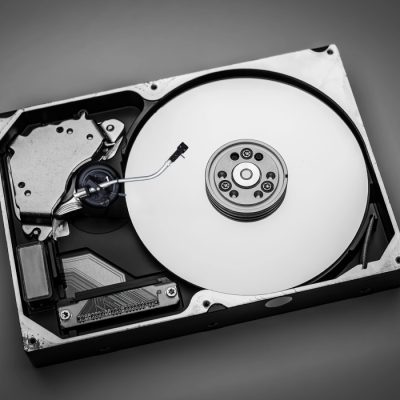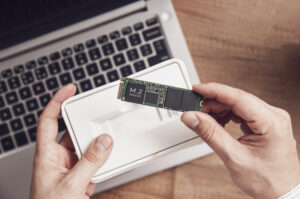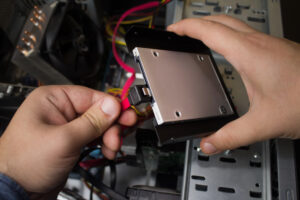When it comes to data recovery, knowing the difference between SSD vs. HDD can be a game changer.
We’ve come a long way from the external punch card storage employed by ENIAC, the first programmable computer, completed in 1945. Not until 1953 did ENIAC acquire a 100-word magnetic-core memory. By today’s standards, that degree of storage is dismally poor. These days, Cloud storage—with its virtually unlimited capacity—is all the rage. Yet, for a quick, economical data backup option that doesn’t require a subscription, nothing beats hard drive storage.
But no data backup option is infallible. Punch cards get lost, and Cloud storage becomes inaccessible if you end your subscription. By the same token, even the most dependable hard drives can become corrupted. When this dreaded moment occurs, you need quick solutions to avoid losing valuable information.
Data recovery is the obvious answer. But many computer users remain unaware that all hard drives are not created equal. Depending on the type of hard drives you have, the recovery processes may differ widely from one another. To clarify the differences in play, let’s define the two types of hard drives commonly found in home and business settings.
SSD vs. HDD: How Do SSDs and HDDs Differ?
First of all, solid-state drives (SSDs) use only stationary components and incorporate flash-based memory. The advantage of flash storage is that it remains stable (nonvolatile) even when separated from a power source. Read-only memory (ROM) was an early example of nonvolatile data storage. However, SSDs take the advantages of nonvolatile memory to the next level.
Data remains encapsulated in the SSD “cells” until the user electronically retrieves it. Due to the storage method, users can save information to the SSD, delete it, and save new information in place of the old details. This process of saving, deleting, and resaving—technically called “writing” and “rewriting” data—can occur thousands of times on a single SSD.
Writing information to an SSD involves programming data to a series of interconnected NAND flash memory chips. However, it’s crucial to note that the user cannot rewrite new data over an existing data block. He must first delete the old information to make room for the new.
Overall, SSDs are a popular storage option for several reasons. Choosing an SSD provides the following perks:
- Faster access speed/lower latency.
- Faster read speed—up to 550 megabytes per second (MB/s).
- Faster write speed—up to 500 MB/s.
- Increased durability.
- Greater energy efficiency.
Yet, the above figures represent the abilities of consumer-grade SSDs only. High-performance SSDs read at the lightning-fast rate of 3,500 MB/s and write up to 3,000 MB/s. On the downside, SSD storage usually costs more per gigabyte than the alternative. And the high-performance options cost significantly more than the consumer-grade versions.
You’ll commonly find the referenced alternate storage method, hard disk drives (HDDs), in desktop and laptop computers. Rotational platters within the HDD access files via an actuator arm, which then transfers data to a different location for reading. This process is possible due to a thin magnetic coating on the platters along with rapid airflow caused by the spinning disk. The high-speed rotation causes tiny “heads” to hover above the disk’s surface. These heads use binary code, composed of only 0’s and 1’s, to write data to the magnetic layer. When the user wants to access data, the heads will read the stored information in terms of spots associated with magnetic north and south.
A steel case protects all this crucial equipment from damage. Nonetheless, if the user drops the hard drive while the computer is running, irreparable damage may occur. Due to the damage, the user may find a part or all of his stored data inaccessible.
And as with SSD, HDD is also nonvolatile. Therefore, on this basis alone, the two types of storage may appear equal. Yet, SDD outstrips HDD in access speed as well as read and write speeds. HDDs read and write speeds top out at a mere 160 MB/s.
Additionally, HDD storage is nonsequential. That is, the heads deposit details in random order in empty spaces on the hard drive. Over time, this fragmented information takes up an inordinate amount of storage. When this issue occurs, the hard disk has become “fragmented.” To regain useable storage space, the user may need to periodically reorganize information on his HDD. The term for this reorganizing process is defragmentation.
However, despite potential drawbacks, many consumers continue to opt for HDD storage. Why? Here are a few reasons to consider HDD for your computing needs:
- Durability.
- Good performance.
- Good data capacity (varying according to the size of the drive).
- Low cost.
On both the personal and professional levels, the price tag is sometimes the bottom line! For this reason alone, computer manufacturers include internal hard drives in their standard computer models. Some users may also purchase external storage drives to boost their computers’ storage capabilities. And users may back up anything from crucial business data to priceless family photos on these convenient devices.
Consequently, regardless of what storage method you choose, finding your hard drive data inaccessible can be highly stressful. However, armed with a bit of knowledge, you can find these inescapable moments more endurable.
SSD vs. HDD: SSD Data Recovery Process
By some accounts, recovering data from an SSD is impossible. However, although the process is more complex than similar processes associated with HDD, here’s the good news. Certain methods do exist for recovering data from SSDs.
Although this article cannot cover every possible data recovery method, here are some recommended best practices to optimize your results:
- Disconnect the SSD from the attached device as soon as you notice a storage loss. By doing so, you may stop the TRIM command from triggering. This command, originating in the Advanced Technology Attachment (ATA), identifies unusable files and deletes them to lengthen the life of the SSD. However, if the system triggers this command before data recovery occurs, many files may become irretrievable. The good news is that corrupted file systems, power failures, sudden partition loss, software errors, and other common reasons for data loss rarely trigger TRIM. However, where your data is concerned, you would be best served to play it safe. If you cannot connect the SSD to a different device, power off your computer till you are ready to start the recovery process.
- Install data recovery software on your computer before a storage loss occurs. That way, when you find yourself in this quandary, you can immediately get to work recovering your files. However, if you experience data loss before you install the recovery software . . .
- Do NOT install the software on the computer where the data loss occurred. If you do, the new file could overwrite your old data, rendering it impossible to recover.
- Don’t count the cost when choosing your recovery software. If you’re serious about recovering your lost information, you’ll select the best option at your disposal. Depending on the software you choose, the recovery processes may differ slightly.
SSD vs. HDD: HDD Data Recovery Process
Contrastingly, HDD data loss is more straightforward. Instead of data loss triggered by TRIM, HDDs typically experience data loss after sustaining physical damage. Unfortunately, in the case of physical damage, HDD data often becomes irretrievable.
However, if you have an undamaged HDD, you have good odds of recovering your files intact. Common examples of this type of data loss include accidentally deleting files or formatting your hard drive. It’s important to note that formatting a hard drive makes files impossible for the system to find because it loses track of where the data is located. Other common issues that cause HDD data loss are power outages, overheating, and normal wear and tear. Apart from these issues, malware attacks, structural flaws, and random system errors may have negative effects on data. But as long as no new data overwrites the old information before recovery occurs, there is a lot of hope for good results.
When you experience data loss on your HDD, here are some important thoughts to keep in mind:
- Do NOT empty your recycle bin. Doing so deletes the reference points your hard drive uses to identify and retrieve data.
- Immediately install data recovery software when you acquire the computer and before data loss occurs (see above).
- Once again, use the best data recovery software available.
Losing cherished files and photos can prove distressing enough—apart from the stress associated with recovery. If you select inferior software or accidentally overwrite your previous files, the results may be disastrous. Plus, pitfalls abound for accidentally rendering your files irrecoverable. Clearly, data recovery falls into the category of “don’t try this at home.” When files go missing, call professional help immediately to secure the best possible chance of data recovery.
Jet Data Professional Data Recovery has specialists standing by to help. Please visit our shipping and packaging instructions here for more detail on sending us your hard drive. Be sure to include your name and contact information in the package in case your return address becomes obscured during shipping. You may also call us at 1 (833) 538-3282 for further information about our services and to request pricing estimates. We’d never wish data loss on anyone, but if it happens to you, be sure to call Jet Data Pro for all your data recovery needs.



